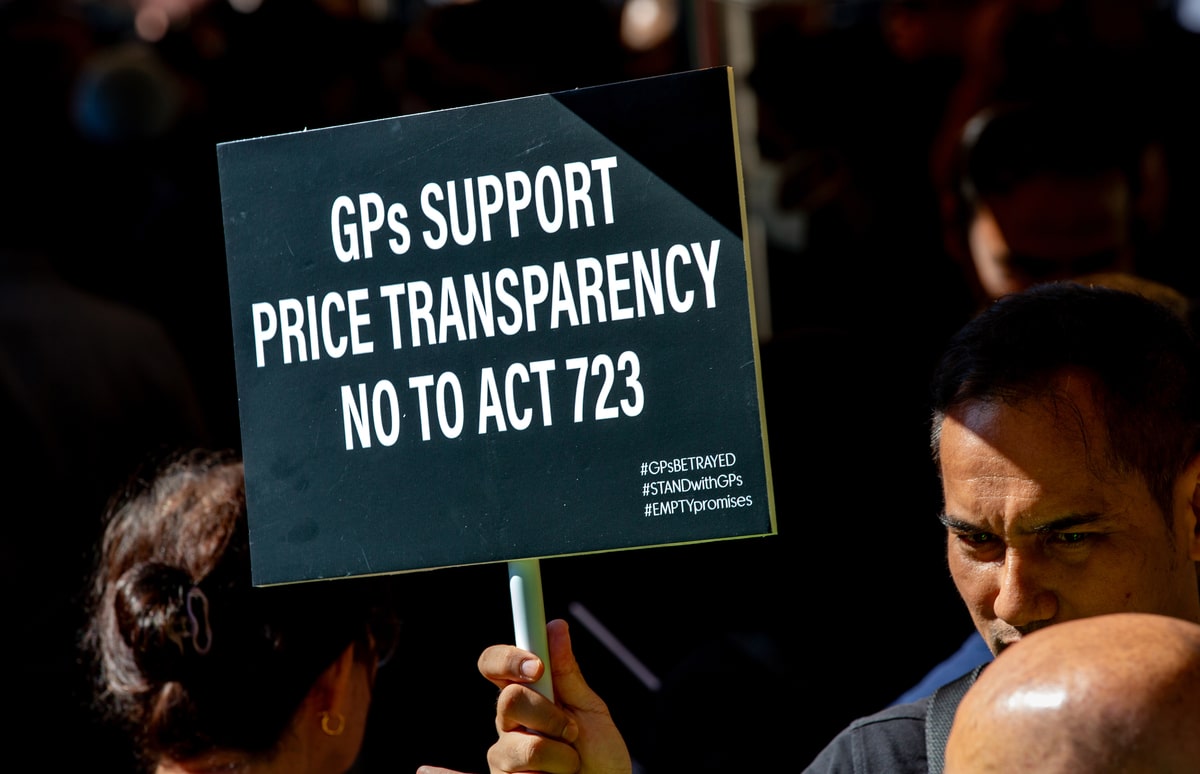PUTRAJAYA, May 8 — At least one private general practitioner (GP) says his patients have largely ignored the medicine price list at his clinic, raising questions about the usefulness of the price transparency policy.
Dr Shah Jahan Abdul Khalim – a GP who runs Poliklinik Seri Mas in Cheras, Kuala Lumpur – said his clinic has already displayed medicine prices in compliance with the Price Control and Anti-Profiteering (Price Marking for Drug) Order 2025 that came into effect May 1. But patients have not shown any interest in the price list.
“There’s a Q&A booklet by KKM. It’s a bit tedious but there’s supposed to be four columns – one is the generic name of the medicine, one is the pharmacological name, the price per unit, and the price we are selling. So, there are four columns. We wrote everything down.
“We printed out everything and placed it in a transparent folder at the reception counter – we have over 300 medicines, injections, everything,” Dr Shah Jahan told CodeBlue during a doctors’ rally last Tuesday against the Domestic Trade and Cost of Living Ministry’s (KPDN) jurisdiction over drug price display.
“But so far, it has been a week and no one has even looked at it. They (patients) don’t even ask what it is.
“They just come, register, go in for consultation, pick up their medicine, pay, and leave. This is the relationship we have with our patients – it’s transparent. They trust us. They come to us, we treat them, we discuss the diagnosis, do everything in a transparent manner, and they are happy.”
Dr Shah Jahan added that most of his GP friends who have complied with mandatory price display similarly found that their patients didn’t bother looking at the lists of medicine prices.
“So I don’t understand why we need to do it. But it’s okay, we can follow whatever is in the guidelines. But using Act 723 (Price Control and Anti-Profiteering Act 2011) to implement and take action against GPs is a big no for us.”
The historic demonstration by more than 700 private GPs and specialists in Putrajaya expressed support for price transparency, but called for the drug price display mandate to be placed under the Ministry of Health’s (MOH) jurisdiction instead of the Domestic Trade and Cost of Living Ministry (KPDN).
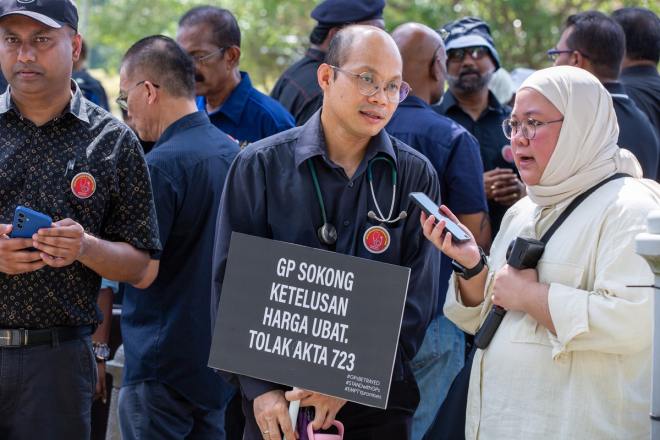 Dr Shah Jahan Abdul Karim, a private general practitioner (GP) who runs a clinic in Kuala Lumpur, participates in a doctors’ rally in Putrajaya on May 6, 2025, against the Domestic Trade and Cost of Living Ministry’s (KPDN) jurisdiction over mandatory drug price display under the Price Control and Anti-Profiteering Act 2011 (Act 723). Photo by Sam Tham for CodeBlue.
Dr Shah Jahan Abdul Karim, a private general practitioner (GP) who runs a clinic in Kuala Lumpur, participates in a doctors’ rally in Putrajaya on May 6, 2025, against the Domestic Trade and Cost of Living Ministry’s (KPDN) jurisdiction over mandatory drug price display under the Price Control and Anti-Profiteering Act 2011 (Act 723). Photo by Sam Tham for CodeBlue.
Dr Shah Jahan said GPs are not against price transparency, but object to KPDN’s enforcement of the price display mandate under Act 723.
“We’re okay with price transparency. We’ve always told patients before we prescribe – ‘this is how much it will cost. Are you okay with that?’” he said. “But we have a problem with Act 723. We’re not comfortable with a different agency coming in to mingle in our business.
“If they use Act 586 (Private Healthcare Facilities and Services Act 1998) instead, we will comply. We just don’t want other people coming in, doing inspections, and taking action. That’s what we’re not comfortable with.”
He added that implementing the drug price list is burdensome for small GP clinics. “We have to print the prices, update from time to time – it takes away from our clinical work. Most doctors are in their 50s or 60s. You can’t expect them to be IT-savvy.”
Dr Shah Jahan runs his clinic with his father; the practice employs two staff and a cleaner.
Private health care facilities routinely face inspections under Act 586 from the Private Medical Practice Control Section (CKAPS) at the MOH.
CodeBlue previously reported three lawyers as saying that the MOH lacks the legal authority (“punca kuasa”) to enforce the drug price display order that can only be enforced by KPDN, as the domestic trade and cost of living minister’s power under Section 3 of Act 723 is “non-delegable” or cannot be transferred to another minister.
‘We Are Not Retailers’
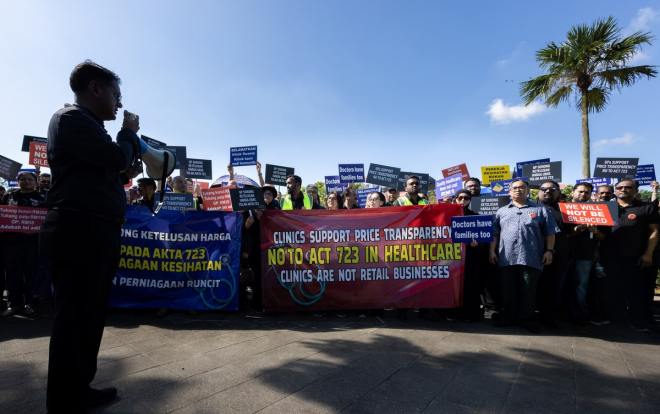 Doctors gather at a rally in Putrajaya on May 6, 2025, to protest the Domestic Trade and Cost of Living Ministry’s (KPDN) jurisdiction over mandatory drug price display under the Price Control and Anti-Profiteering Act 2011 (Act 723). Photo by Sam Tham for CodeBlue.
Doctors gather at a rally in Putrajaya on May 6, 2025, to protest the Domestic Trade and Cost of Living Ministry’s (KPDN) jurisdiction over mandatory drug price display under the Price Control and Anti-Profiteering Act 2011 (Act 723). Photo by Sam Tham for CodeBlue.
Dr Balachandran Krishnan – a GP with a special interest in occupational health from Poliklinik Cahaya in Brickfields and Pandan Perdana, Kuala Lumpur – said the issue is not about price display per se, but about how it is enforced.
“We don’t mind drug price transparency, but the way they implement it is very important because we are not retailers – we are a service industry,” Dr Balachandran told CodeBlue during the protest.
“We already have a comprehensive law under PHFSA. Act 586 is strong enough. Now there’s another one, and we’re finding it very, very difficult.”
Dr Balachandran noted that GPs are already regulated by multiple government bodies; the addition of KPDN makes matters worse. “We are facing too many regulators. With KPDN, it’s the fifth or sixth ministry. It’s just too much.”
He said KPDN’s enforcement approach is inappropriate for the health care setting: “When KPDN officers go into retail shops, the way they behave is different. If they walk into a GP clinic the same way as a workshop, there will be a problem. It’s not nice. We are professionals. We want the government to treat us as professionals.”
CodeBlue previously reported doctors’ derision at a KPDN video showing price display enforcement at a car service workshop. KPDN’s TikTok video was filled with memes, including a movie scene showing cigarette smoking.
Dr Balachandran also highlighted stagnant consultation fees as a deeper frustration behind the rally. “For 33 years, our consultation fees have not been reviewed. Nasi lemak prices have gone up. Everything has gone up – but not GP fees,” he said. “We’re suffering.”
“We don’t want to do this sort of thing, but we’ve been pushed to a corner. We have no choice.”
GPs’ consultation fees under Schedule 7 of Act 586 have been capped at RM10 to RM35 for more than three decades.
TPAs Restricting Doctors’ Dispensing Rights, Says Klang GP
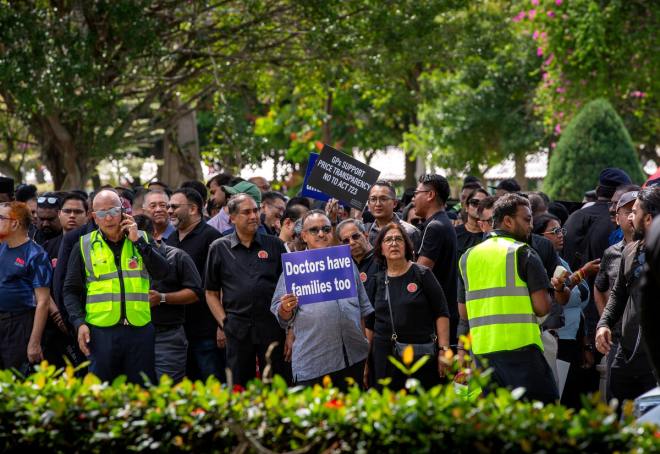 Doctors gather at a rally in Putrajaya on May 6, 2025, to protest the Domestic Trade and Cost of Living Ministry’s (KPDN) jurisdiction over mandatory drug price display under the Price Control and Anti-Profiteering Act 2011 (Act 723). Photo by Sam Tham for CodeBlue.
Doctors gather at a rally in Putrajaya on May 6, 2025, to protest the Domestic Trade and Cost of Living Ministry’s (KPDN) jurisdiction over mandatory drug price display under the Price Control and Anti-Profiteering Act 2011 (Act 723). Photo by Sam Tham for CodeBlue.
Dr Sarah (pseudonym) – who has been in general practice for nearly three decades and owns two GP clinics in Klang and Kota Damansara, Selangor – said GPs have accepted the price display requirement, but are increasingly burdened by overlapping regulations and stagnant income.
“This latest order with price displays, we have no issues with that,” said Dr Sarah. “But we want them to address the first issue (consultation fees) first because that is what makes us sustainable as we are on our own. We don’t have anyone backing us up.
“Right now, we are subjected to all sorts of regulations from many different agencies – with e-invoicing, rentals going up, everything going up but our consultation fees remaining stagnant. We can’t raise it because it has not been gazetted yet.
“On top of that, the consultation rate for Malaysian private general practitioners is also one of the lowest in the Asean region.”
She added: “All this while we’ve been regulated by CKAPS. Now, we are answerable to so many agencies and that’s our problem. If we don’t speak out now, there’ll be more things coming out when our main issue hasn’t been dealt with.”
Dr Sarah said the medicine price display policy comes at a time when private GPs are already struggling to stay afloat amid rising costs and lower patient volumes.
“The last couple of years have been a bit slow for all of us in terms of the number of patients because firstly the number of clinics have been mushrooming… it’s as if there is no control from the relevant authorities,” she said. “By right, there should be a zoning system so that there is no overpopulation of clinics in any particular area.”
She added that the poor economy has also affected patient numbers.
“The current economy is not so good, so we are receiving less patients. Our overhead keeps on increasing. That’s the problem. Our rental, utilities, even the cost of medication – every year it keeps rising. It just feels like they are adding more burden on us day by day.”
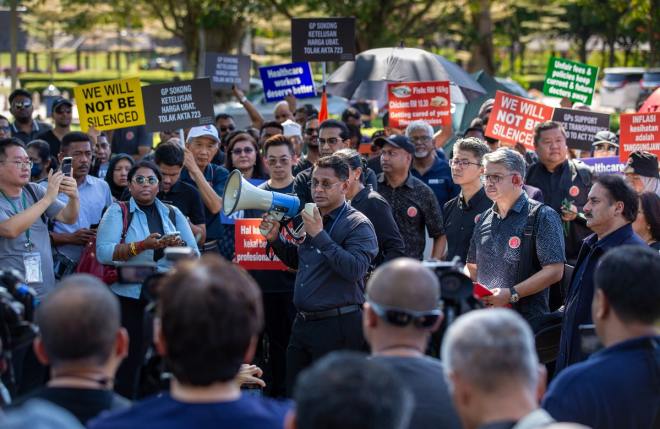 Malaysian Medical Association president-elect Dr R. Arasu speaks at a doctors’ rally in Putrajaya on May 6, 2025, to protest the Domestic Trade and Cost of Living Ministry’s (KPDN) jurisdiction over mandatory drug price display under the Price Control and Anti-Profiteering Act 2011 (Act 723). Photo by Sam Tham for CodeBlue.
Malaysian Medical Association president-elect Dr R. Arasu speaks at a doctors’ rally in Putrajaya on May 6, 2025, to protest the Domestic Trade and Cost of Living Ministry’s (KPDN) jurisdiction over mandatory drug price display under the Price Control and Anti-Profiteering Act 2011 (Act 723). Photo by Sam Tham for CodeBlue.
Dr Sarah also noted that some third-party administrators (TPAs) have stopped GPs from dispensing long-term medications.
“Some of the big TPAs now do not allow us to supply medication to our patients anymore,” she said. “We’re just allowed to examine and prescribe. Patients have to go to pharmacies appointed by TPAs to collect their meds – and sometimes the pharmacies are far away.”
She believes the move is driven by cost-cutting and raised concerns that TPAs’ influence in the health care system is growing unchecked.
“I presume that the TPAs want to increase their revenue. That is why they have appointed designated pharmacies themselves. Patients now have to go to two different places to get their prescription and then get their medication,” Dr Sarah told CodeBlue, requesting anonymity.
“Patients do complain but it can’t be helped. Wouldn’t it be easier for patients to get everything under one roof? By right, it should be all about simplifying the process of getting treatment for our patients. Maybe this is the beginning of dispensing separation?
“On top of that, TPAs in Malaysia are not 100 per cent regulated. Over the years, TPAs have been adding administrative fees for doctors. Some are charging a fixed amount per bill, some are deducting up to 10 per cent of our total claims. One particular TPA is even charging doctors up to RM5,000 per clinic if we want to apply to be a panel with them. The TPAs are maximising their revenue at every level.”
